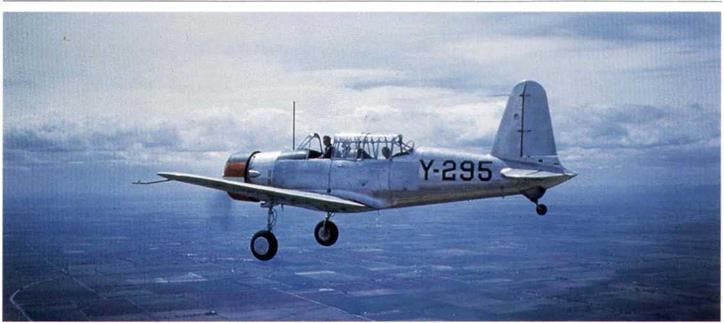TRAINING AND LIGHTER-THAN-AIR AIRCRAFT
7. TRAINERS,
a. The following types of aircraft are considered to be trainers:
(1) Primary Trainers (PT).
(2) Basic Trainers (ВТ).
(3) Advance Trainers (AT).
(4) Training Gliders (TG).
(5) Aircraft of other types regularly used for training purposes by the Flying Training Command.
(6) Ail types of aircraft not regularly assigned to, or normally located in, theaters of operation.
b. FINISHES,—All trainer aircraft will have aluminized finish, except those being by construction having an Alclad alloy finish. (See figure 8.)
c. APPLICATION OF FINISHES.
(1) 
 Anodized alloy and miscellaneous steel parts may have two coats of aluminized lacquer, if necessary to match surrounding parts.
Anodized alloy and miscellaneous steel parts may have two coats of aluminized lacquer, if necessary to match surrounding parts.
|
Vultce ВТ-13, school aircraft “Y-295”, in natural metal finish, shows the lack of a fuselage insignia. The cowl is finished in red and while horizontal hands, below the black anti-glare panel. (USAF via Gerry R. Markgrafl |
(2) All other exterior metal surfaces will be finished with one coat of zinc chromate primer, Specification No. AN-TT-P-656, and two coats of aluminized lacquer consisting of lacquer, cellulose nitrate, class A, clear, Specification No. AN-TT-L-51, with 6 to 8 ounces per gallon of bronze aluminum pigment paste, type B, Specification No. TT-A-468 or AN-TT-A-461.
(3) Exterior plywood surfaces will be finished in accordance with manufacturers’ instructions except that two or more finish coats will be pigmented with 8 ounces per gallon of bronze aluminum, pigment paste, Specification No. TT-A-468 type B, or Specification No. AN-TT-A-461.
(4) All exterior fabric parts will have four coats of clear nitrate dope, Specification No. AN-TT-D – 514. (Aluminized dope vehicle AN-TT-D-551 is not a suitable substitute as it does not have the tautening qualities of AN-TT-D-514.)This will be followed by two or more coats of aluminized dope prepared by adding 6 to 8 ounces per gallon of bronze, aluminum pigment paste, type B, Specification No. TT-A-468 or AN-TT-A461, to dope, cellulose nitrate, clear, Specification No. AN-TT-D-551.
(5) Patching will be accomplished with clear dope, Specification No. AN-TT-D-514 applied in same manner as semipigmented dope previously used.
(6) EMERGENCY REJUVENATOR FOR OLD FABRIC,—To one gallon of 2 to 1 mix of clear dope, Specification No. AN-TT-D-514, and blush retarding thinner, Specification No. AN-TT-T-258, add one fluid ounce each of tricresyl phosphate and castor oil. Apply one coat by brush to clean surface, followed by one spray coat. After several hours’ drying, spray one coat aluminized dope prepared as specified in paragraph 7.a.(4).
(7) For removal of all types of paint material from metal surfaces, use paint and varnish remover, Specification No. 14119. For removal of dope from fabric surfaces, use nitrate dope and lacquer thinner, Specification No. AN-TT-T-256.
d. MARKINGS.
(1) Each part and assembly will be permanently and legibly marked with the same number as the drawing number in such location that it can be read after assembly in the unit. (See Specification No. 98- 24105-Q.)
(2) Various detail and code markings for the cockpit, fuselage, oil lines, etc., as required in Specification No. 98-24105-Q will be maintained. Use of one coat of varnish, Specification No. TT-V-121 orAN-TT – V-116, for protection of fuselage legend is authorized.
(3) Radio call letters will be used as prescribed in paragraph 3.c.
(4) Painting of ring cowls is authorized in colors as directed by the CommandingGeneral of the Flying Training Command.
(5) Field numbers are authorized as designated by the Commanding General of the Flying Training Command for use in Army Air Forces Training Centers and Civil Flying Schools. They will be of contrasting color, preferably block type, and will be applied to opposite sides of the fuselage between the trailing edge of the wing and the leading edge of the horizontal stabilizer directly in front of the star insignia. The height will be approximately 75 percent of the height of fuselage at that point. (See figure 8.)
e. Standard insignia will be used as prescribed in paragraph 4.
|
Vultee BT-13,42-42817, aircraft “31?", is seen after the fuselage insignia has been applied. The cowl is yellow’ with a centered insignia blue ring. Note the blue and yellow aircraft next in the lineup. (USAF via Gerry R. Markgraf) |
/. All markings and insignia will be made with enamel, Specification No. AN-E-3, insignia colors in oil. Specification No. 3-120, or lacquer, Specification No. AN-TT-L-51.












